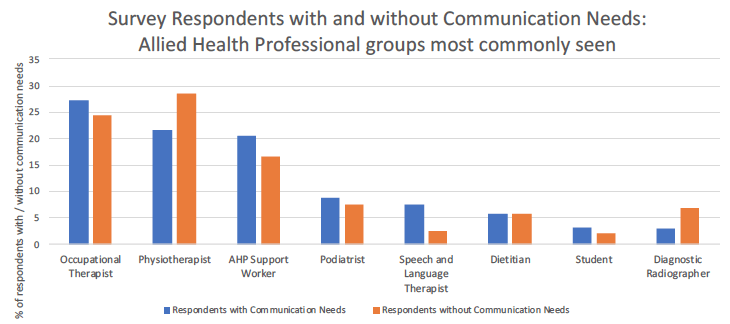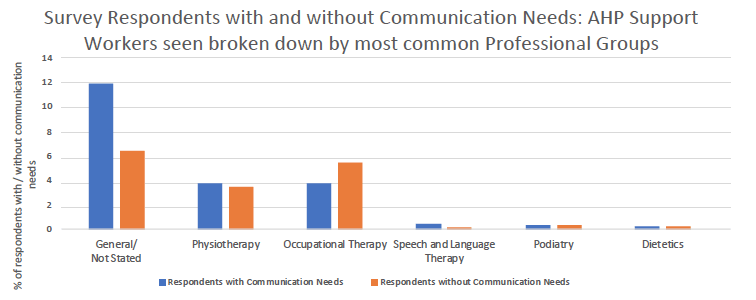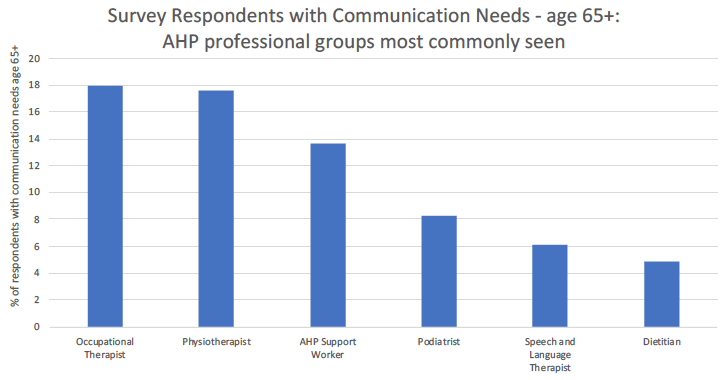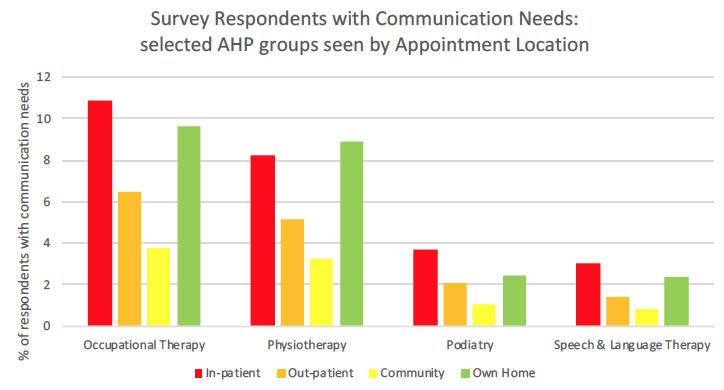Allied health professions LifecurveTM survey: report on respondents with communication support needs
Provisional analysis of findings from a major survey of clients of allied health professionals (AHPs), focused on survey respondents who reported having communication support needs.
9. Allied Health Professional Background
9.1 Allied Health Profession Seen at this Appointment
Data was available for 96% of respondents with (n=2759) and without (n=10002) communication support needs.
As noted earlier, each survey response relates to one AHP appointment only, and does not capture information about the respondent's other interactions with the same or other AHPs, or with other health and social care services.
AHP information is broken down by overall professional group, and the staff members' role within that group: for example 'Occupational Therapy' includes occupational therapists, AHP support workers, and student occupational therapists. About three quarters of respondents were seen by AHPs, around 20% were seen by AHP support workers, and fewer than 3% were students.
The AHP groups which saw the highest proportions of survey respondents are shown below in Figure 21. Around half of respondents, both those with and without communication support needs, saw either an occupational therapist or physiotherapist. Around 7% of respondents with communication support needs saw a speech and language therapist, compared with 3% of respondents without.

Figure 21: Survey respondents with and without communication support needs: Allied Health Professional group seen
AHP support workers saw 21% of respondents with communication support needs, suggesting that this group would benefit from skills in supported communication to adequately support their patients. Support workers include assistant practitioners who have skills in a particular area through on-the-job training and experience, and clinical support workers who provide more general support. Where information was available, the AHP support workers were grouped according to the professional group they supported, with physiotherapy and occupational therapy the most common. Otherwise they were categorised as 'General/Not Stated', which was the most common grouping. A breakdown of support workers by professional group is shown in Figure 22 below.

Figure 22: Survey respondents with and without communication support needs: Allied Health Professional Support Workers seen broken down by professional group
9.2 Allied Health Profession Seen by Age of Respondent
Information on AHP seen and age of respondent was available for 41% of respondents with (n=1184) and 43% (n=4457) of respondents without communication support needs.
As stated earlier, 75% of survey respondents with communication support needs were aged 65+, and the profile of AHPs seen by that age group is shown below in Figure 23. The AHP groups most frequently seen were, once again, occupational therapists and physiotherapists, at around 18% each, followed by AHP support workers. Six per cent of the 65+ age group were seen by speech and language therapists.

Figure 23: Survey respondents with communication support needs – age 65+: Allied Health Professional group seen
9.3 Allied Health Profession Seen by Location
Data was available for 95% (n=2743) of respondents with and 99% (n=10365) of respondents without communication support needs.
The breakdown of respondents with communication support needs for the four AHP groups most frequently seen (including their support workers and students) and location is shown below in Figure 24. These groups saw around three quarters of this group of respondents, across all appointment locations, but were all more likely to see respondents as in-patients or at home.

Figure 24: Survey respondents with communication support needs: by selected AHP group and appointment location
9.4 Allied Health Profession Seen by Age and Location
Data by AHP seen, appointment location and age was available for 41% (n=1178) of respondents with and 42% (n=4436) of respondents without communication support needs.
Respondents aged 65+ comprised 75% of those with communication support needs and their pattern of appointment locations was similar to the 'all ages' group. The pattern for respondents aged under-65 (comprising 25% of those with communication support needs) was more mixed, but this analysis was derived from relatively small numbers of respondents.
Contact
Email: debbie.sagar@gov.scot
There is a problem
Thanks for your feedback